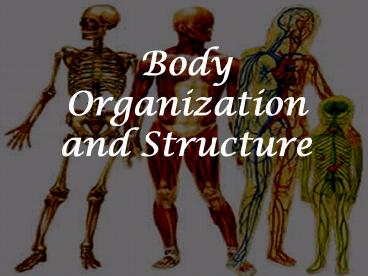Body Organization and Structure - PowerPoint PPT Presentation
Title:
Body Organization and Structure
Description:
Body Organization and Structure DO AN ICE JOB! 1. What initially happens when the ice touches your skin? 2. What happens after more time passes? – PowerPoint PPT presentation
Number of Views:58
Avg rating:3.0/5.0
Title: Body Organization and Structure
1
Body Organization and Structure
2
DO AN ICE JOB!
- 1. What initially happens when the ice touches
your skin? - 2. What happens after more time passes?
- 3. What happens when the ice is removed?
- 4. How do you think Jack Thayer managed to
survive after the sinking of the Titanic?
3
HOMEOSTASIS
If homeostasis is interrupted, cells suffer and
sometimes die.
- The human bodys maintenance of a stable
internal environment.
My Beloved Cells I will miss you!
4
THE WORK OF CELLS
- On a baseball team, every
player has his job.
Cells have their own positions (or jobs) in the
body!
5
RED BLOOD CELLS
6
Groups of cells working together form a TISSUE
- There are 4 types of tissues
- Epithelial Tissue
- Nervous Tissue
- Muscle Tissue
- Connective Tissue
7
EPITHELIAL TISSUE
- Covers and protects underlying tissue. When you
look at the surface of your skin, you see
epithelial tissue
8
NERVOUS TISSUE
- Sends electrical signals through the body. It is
found in the brain, nerves and sense organs.
9
MUSCLE TISSUE
- Made up of cells that can contract and relax to
produce movement
10
CONNECTIVE TISSUE
- Joins, supports, protects, insulates,
nourishes, and cushions organs. It also keeps
organs from falling apart.
11
TISSUE TISSUE ORGAN
- Two or more tissues working together, form an
organ.
One type of tissue alone cannot do all of the
things that several types working together can
do.
12
ORGAN ORGAN ORGAN SYSTEM
- Organs working together
- make up an organ system.
The failure of any part can affect the entire
system
13
11 MAJOR ORGAN SYSTEMS
- Integumentary system
- Muscular system
- Skeletal system
- Cardiovascular system
- Respiratory system
- Urinary system
- Reproductive system.
- Nervous system
- Lymphatic system
- Digestive system
- Endocrine system
14
Integumentary System
- Includes skin, hair, nails and their underlying
tissues
15
Muscular System
- Skeletal muscles move bones.
16
Skeletal System
- Bones frame and protect body parts.
17
Cardiovascular System
- The heart pumps blood through blood vessels.
18
Respiratory System
- Lungs absorb oxygen and release carbon dioxide.
19
Urinary System
- Removes wastes from the blood and regulates body
fluids.
20
Reproductive System
- Females produces eggs, feed/shelter unborn baby-
males produce sperm.
21
Nervous System
- Receives and sends electrical messages.
22
Lymphatic System
- Returns leaked fluids to blood vessels and helps
flush harmful germs out.
23
Digestive System
- Breaks down food into nutrients.
24
Endocrine System
- Glands regulate body functions by sending out
chemical messages.
25
(No Transcript)
26
DISCUSSION QUESTIONS
1. Explain the relationship between cells,
tissues, organs and organ systems. 2. Compare
the four kinds of tissues found in the human
body. 3. Describe a time when homeostasis was
disrupted in your body. Which body systems do
you think were effected?
27
T/F QUICK QUIZ
- Homeostasis is the maintenance of a stable
internal environment. - Epithelial tissue sends electrical signals
throughout the body. - Blood is a type of connective tissue.
- The endocrine system consists of skin, hair,
nails and their underlying - tissue.
- 5. The lymphatic system returns
- leaked fluids to blood vessels.
28
(No Transcript)
29
- beating heart surgery
- http//www.youtube.com/watch?vN_LuJGobrpwNR1































